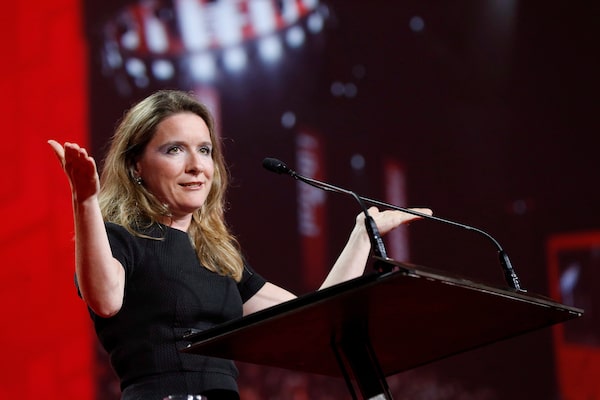
Katie Telford, 2015 national campaign co-chair speaks at the 2016 Liberal Biennial Convention in Winnipeg on May 27, 2016.JOHN WOODS/The Canadian Press
The speculation among federal Liberals was that, around now, Katie Telford would leave her job as Justin Trudeau’s chief of staff to resume her role as their party’s national campaign director.
That was before scandal hit, and Gerald Butts resigned as Mr. Trudeau’s principal secretary, and the idea of the other top staffer in the Prime Minister’s Office also exiting became almost unthinkable – at least as long as their government is in crisis mode.
Consider that a manifestation of how the SNC-Lavalin affair may already be having an impact on this year’s federal election.
There is no telling how the saga will affect Canadians’ voting decisions in October – not without knowing how much it will continue to dominate the news, what twists it has yet to take and how it will affect broader perceptions of Mr. Trudeau relative to his opponents.
But if seven months is a long time in terms of news cycles and voter intentions, it’s a much shorter one when it comes to behind-the-scenes preparation – message testing, candidate training, volunteer engagement, voter contact, procurement – that political parties put into national campaigns. And for the Liberals, their current woes can’t be helping them make full use of that window.
Even before SNC-Lavalin overtook Ottawa, there was a little concern in Liberal circles that the party was being slow to rev up its campaign machine into gear – at least relative to before the previous election, in 2015, when it spent a couple of years in full-throttle organizational mode, firing up its grassroots and experimenting with new technologies and generally readying itself to run the most innovative and energetic campaign among the major parties. To some eyes, it looked as though the Liberals could fall prey to a typical danger for governing parties of being out outhustled by hungrier opponents.
Liberal officials push back hard against any perception of complacency, with party communications director Braeden Caley citing an array of metrics – such as “more than 1.3 million new conversations with Canadians over the past year, and more than 700 volunteer engagement events in 2018” – to argue the pre-election work is well underway. To avoid incumbents trying to coast toward re-election, the Liberals set certain goals that MPs had to meet (such as a minimum number of constituents’ doors they had to knock on) before being re-nominated.
But what nobody really disputes is that we’re at the point, especially coming out of next week’s budget, where the Liberals would like to shift election readiness into another gear. And the scandal is at minimum a big distraction as they attempt to do so.
For starters, all the SNC-Lavalin noise will make it harder for them to immediately start selling election-friendly measures (on pharmacare, for instance) of a budget meant partly to serve as a campaign document. A coming spate of advertising which the Liberals have recently been producing may help. But they would prefer to also get their post-budget message to voters through the media, not work around terrible coverage.
Meanwhile, the morale-killing effect of the way the saga has played out could make it harder to entice even loyal supporters to resume canvassing for Liberal candidates, let alone recruit new volunteers. Of all the times to reach out directly to voters, this may not be the most inviting one.
But the biggest challenges may be at the top of their campaign organization chart. It’s still expected that Ms. Telford will resume her role, after overseeing the modernization of the Liberals’ operations before the last election. But given recent events, it’s unlikely she’ll do so before summer. And while it would be naive to believe she won’t spend some of her time in PMO dealing with campaign preparation, there’s only so much bandwidth that anyone can have.
The Liberals have capable people well-versed in modern campaign methods working full-time on the party side (among them national director Azam Ishmael, who has a strong background in digital outreach). But beyond just Ms. Telford, they’ve had the same personnel challenge as most parties that hold power: Many of the people who played pivotal roles on the campaign that got them there are now in government, without much time to devote to political organization. And while some are starting to trickle back to the party side now, they’d be better able to do so if the government were sailing smoothly into the spring.
Amid all this, there is one top person in Mr. Trudeau’s orbit who now has more time on his hands than expected. Mr. Butts – who was instrumental last campaign in everything from policy development to messaging to advertising strategy – could start focusing squarely on pre-election matters now that he’s no longer in the PMO.
It’s unclear if Mr. Butts, who has been keeping his head down lately other than at this month’s parliamentary committee appearance, intends to do anything of the kind. If he does, it will make for a bit of a different fit: As essential as he has been to Mr. Trudeau over the years, in policy development and messaging and the crafting of the PM’s political identity, he has previously focused less than Ms. Telford on the sorts of operational imperatives that a national campaign faces at this stage of the cycle.
But then, “different” probably understates the pre-election circumstances, relative to what the Liberals expected them to look like just a couple of months ago. They have little choice but to adjust, one way or another.